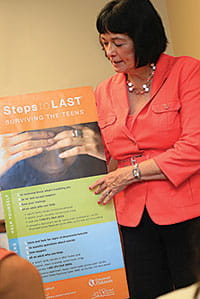Surviving the Teens: A Path to Help

Jordan Fry learns about the Surviving the Teens Program from program director, Cathy Strunk.
“Why is this lady wasting time in a place like our school?”
That was what one teenager thought as she listened to Cathy Strunk’s presentation on depression and suicide. It didn’t seem relevant − until the next day, when a friend told her he was upset, failing school and wanted to kill himself.
Fortunately, she knew what to do. She told her friend over and over how much she valued his life, and then she told a teacher and got him help.
Talk About It
Every 14 minutes, someone in the US dies of suicide. In our community, the Emergency Department at Cincinnati Children’s sees 5,000 children a year for mental health evaluation, including over 2,000 with thoughts of suicide.
From 2011 to 2015, mental health admissions at Cincinnati Children’s rose by 70 percent, and in fact, the No. 1 reason children are admitted to the hospital is to treat depression. Not all people who are depressed commit suicide; however, 90 percent of those who do make an attempt suffer from depression or another mental disorder.
One way the Division of Psychiatry at Cincinnati Children’s works to prevent suicide is by offering Surviving the Teens, an outreach education program that brings educators and survivors into areas schools to talk about teenage suicide.
Surviving the Teens takes a unique approach to suicide prevention education by meeting students in small groups and working collaboratively with teachers and parents.
Reaching Out to Save Lives
Cathy Strunk, MSN, RN, program director, developed Surviving the Teens to teach teens, parents and teachers to recognize the stressors, warning signs and behaviors that may signal depression and suicide risk in teens − and know how to help.
She discusses difficult situations − including abuse, grief, teasing and bullying − that can trigger depression. She teaches students how to recognize depression and suicidal behavior in themselves or a friend. She talks about positive ways of coping with stressors. She gives tips on how to respond to a depressed or suicidal teen, and educates students, teachers and parents about where to go for help.
She sometimes brings along survivors who share powerful accounts of their own experience. One survivor is Luke, a young man from a successful, ambitious family who responded to academic stress and occasional failure by spiraling into depression. He describes the day he stood in his backyard with a shotgun in his mouth. Fortunately, instead of pulling the trigger, he called his parents for help. Luke was admitted to Cincinnati Children’s, where he met other kids struggle as he does.
Today, he talks openly about his depression because, “I want other kids to realize you’re not alone, and that getting help is the way out of it.”
Another survivor is Sara, now in her 20s and happily married. She tells parent groups her story of being bullied, sexually assaulted and depressed. She mad multiple suicide attempts during high school. “I did not let anyone know that this had happened to me and was why I was acting out this way. “She conveys how important it was for her to finally tell someone and ask for help. Doing so, and having the support of her parents, was crucial to her recovery.
Since Surviving the Teens began in 2001, the program has brought awareness, information and hope to more than 70,000 students, thousands of parents and hundreds of teachers.




